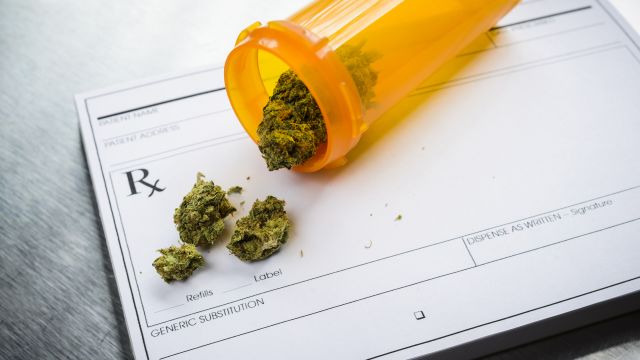Updated on February 14, 2025.
Depending on whom you talk to, medical cannabis (also known as medical marijuana) may be an effective remedy for everything from cancer to chronic pain, or a dangerous and illegal drug with no place in medicine.
Some evidence, however, suggests that legal cannabis could replace alternative treatments and save the government money on healthcare bills. What's more, data suggest that cannabis has a real effect on people’s health.
But can it really help treat medical conditions? Here’s what to know.
Cannabis’ complex legal status
Cannabis’ legal status is complicated, and that affects how it’s studied. Almost every state allows for its medical use. About half of states allow for its regulated recreational use.
But federally, cannabis is classified as a Schedule I drug under the Controlled Substances Act, along with substances like heroin and ecstasy. That means the federal government has found it to have a high potential for abuse with no medical use, and to be unsafe.
Products that contain either of cannabis’ two main ingedients can’t be sold legally as dietary supplements, either. Those two ingredients are:
- Delta-9-tetrahydrocannabinol (THC)
- Cannabidiol (CBD)
The status of cannabis as a Schedule I drug makes getting funding for research into its medical benefits difficult, says Keith Roach, MD, Associate Professor in Clinical Medicine in the division of general medicine at Weill Cornell Medical College and New York Presbyterian Hospital.
“I think it should be reclassified because there’s potential for marijuana to be used in other conditions,” says Dr. Roach. “Saying it has no medical validity is a mistake. Let’s study it.”
Roach says the future of medical marijuana research “depends entirely on the federal government and what they choose to do. Right now, it’s very difficult for researchers to do any kind of good research.”
Elements of cannabis
In addition, cannabis isn’t just one thing—as with any plant, it contains hundreds of compounds with potential health effects, including some very important ones called cannabinoids. The two most common cannabinoids are THC, which is responsible for the “high” that cannabis causes, and CBD, which does not have psychoactive properties.
In November 2017, the World Health Organization (WHO) published a report stating that CBD in its pure form is safe, with little potential for substance abuse and no evidence of harm to public health. The U.S. Drug Enforcement Administration classifies prescription CBD (Epidiolex) as a Schedule V controlled substance, a category that also includes cough syrups. CBD extracted from hemp is not controlled.
CBD is not risk-free—it can interact with other drugs and may cause vomiting, diarrhea, sleepiness, or liver abnormalities. But it also has potential health benefits (read on to learn more). And THC has important medical uses as well.
In fact, the effectiveness of certain compounds found in cannabis is no longer in question, says Roach. “But it’s still controversial because marijuana itself has a lot of different substances in it. We try to isolate one substance and say ‘This is what’s important,’ when it may be several things acting in concert. It’s very difficult to study.”
The health problems marijuana can (and can’t) treat
Cannabis and its many compounds are still being studied and probably will be for many years, so there is a lot that researchers still don’t know. Currently, though, evidence supports the use of cannabis or cannabinoids to treat the following conditions:
- Certain types of pain
- Seizure disorders
- Stimulating the appetite in some patients
- Spastic muscles in people with multiple sclerosis
- Nausea and vomiting due to chemotherapy
- Parkinson’s disease
Two cannabis-derived products called dronabinol and nabilone have FDA-approved indications to treat certain conditions, including chemotherapy-induced nausea and vomiting. And there is an FDA-approved prescription formulation of cannabidiol to treat certain types of seizures in children.
The science is less clear so far on whether it helps with the following:
- Neurodegenerative diseases
- Anxiety and post-traumatic stress disorder (PTSD)
- Addiction
- Cancer
- Inflammation
With regard to cancer, there are some promising lines of research, but many of the studies are in mice. It’s still too soon to be sure of how best to use cannabinoids to help cancer patients. Just as cannabis contains many different compounds, “cancer” includes many different cancer types. So it will be important for researchers to sort out which compounds work, which don’t, and which might even cause harm, in specific types of cancer patients.
In at least one type of cancer, for instance, there is preliminary evidence that cannabinoids could accelerate the disease. Other studies suggest cannabis can interfere with chemotherapy and make people more vulnerable to viral infections. In fact, some scientists have pointed out that cannabis’ ability to suppress the immune system—and the potential dangers to immunocompromised people—is too often overlooked.
Another worrisome possibility is that people could develop cannabis use disorder (CUD), when people use it in a problematic way. Adolescents are much more prone than adults to developing CUD. About 1 in 10 people who start smoking cannabis become addicted. A 2022 study published in JAMA Network Open found evidence that immediate use of medical cannabis by people with pain, insomnia, and symptoms of anxiety or depression increased the risk of CUD without helping them with most of their symptoms.
Responsible use
If you use cannabis or cannabinoids, be aware of its other risks, which may include:
- Interactions with other medications, especially those that affect your mood or make you drowsy
- Interactions with alcohol, tobacco, or illicit drugs
- Higher chance of bleeding if you’re on blood thinners
- Effects on heart rate or blood pressure
- Heart attack
- Testicular cancer
- Effects on your memory, judgment, and decision-making
- Psychosis
- Severe nausea and vomiting (cannabinoid hyperemesis syndrome, or CHS)
- Lower birth weight if smoked during pregnancy
- Fainting or falls upon standing up
- Accidental poisonings, especially of children
- Street cannabis laced with PCP or other drugs
Be aware, too, that due to spotty regulations and quality control, many seemingly innocent preparations of CBD oil are mislabeled or contaminated. In one 2020 study by the U.S. Food and Drug Administration, for example, scientists tested 147 CBD or hemp products being sold on the internet. Of 102 whose labels stated they had a certain amount of CBD, 18 had less than 80 percent of the advertised amount, while 37 had more than 120 percent of the advertised amount. The kicker: About half the samples also contained THC, which means that people using what they think are CBD products could inadvertently be intoxicated by THC.
The Department of Transportation has warned that using a CBD product will not be accepted as an explanation for a positive drug test. One truck driver reportedly lost his job this way.
Heavy metals have shown up in these products, leading in one case to a July 2020 nationwide recall due to lead contamination. Pesticides, microbes, and carcinogens have also been detected in some products.
Cannabis impairs driving, according to the National Institute on Drug Abuse, so if you’re using it it’s best not to get behind the wheel. It is also particularly detrimental to teenagers’ developing brains, impairing thinking and memory for days after use.
Cannabis in some forms has a place in medicine—probably many places. But there is still a lot we don’t know, and fraudulent products are common. If you think medical cannabis might be right for you, protect yourself by consulting a qualified healthcare provider you trust.







